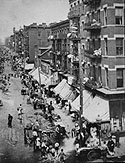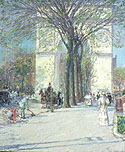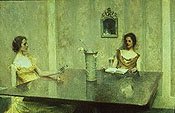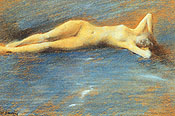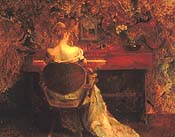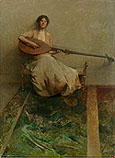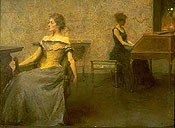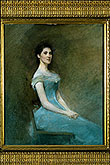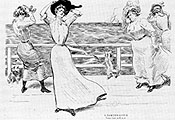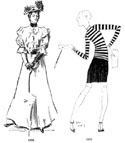The browser will either open the file, download it, or display a dialog.
|
|
On Women and Ambivalence in the Evolutionary Topos |
||||||||||
|
In the decade following the Civil War evolutionary theory shook the foundations of America's self-identity as God's chosen people. On the one hand, Charles Darwin brought the scrutiny of positivist science to bear on biological issues, negating any human uniqueness, while on the other, Herbert Spencer translated evolution into a philosophy of human progress. Spencer's evolutionary philosophy, in particular, had a tremendous impact in the United States because it reconciled the new science with traditional beliefs; it preserved the belief in the special spiritual nature of humankind, as well as the existence of a spiritual realm. The purposefulness of human life on earth thus was upheld, in contrast to Darwin's negation of any human uniqueness. But as Gillian Beer has pointed out, evolutionary science abounded in metaphors and contradictory elements; it could be read as both an ascent and a descent of man. | ||||||||||
|
The term "evolution" in itself connoted a trajectory of development and energy, and in late nineteenth century America, it became synonymous with the idea of progress, particularly as that idea had been established by Spencer and his American followers. Ever present in the consciousness of the Northeastern elite, however, was the fear that the ascent could at any wrong turn become descent, evolution become devolution, progression become retrogression.1 If ascent to the heights of Spencer's prophesied world civilization was the promised land Americans seemed destined to inhabit, the threat of descent into Darwin's primeval nature was always near. Its threat could be measured in the proximity of Manhattan's ghettos to the literary and artistic enclave of Washington Square. (fig. 1 and fig. 2) Representing the position of elite culture, Henry James, for example, touring the Lower East Side in 1905, saw the inhabitants of the tenements as simian creatures hanging from arboreal balconies while Childe Hassam presented the white triumphal arch of Washington Square as the herald of a new world status for Northeastern American culture.2 The high and the low points of ascent and descent, that is, could be mapped within only one or two square miles of urban topography. | ||||||||||
|
This paper argues that the twin poles of this evolutionary discourse, concerning the uncertain direction of human development, could be collapsed into the image of a woman. Moreover, the ascent to civilization purchased in this image of woman came at the price of feminine bodilessness, and potentially carried within it a descent into nature which insisted upon masculine desire. This dual trajectory is played out no where more strikingly than in the paintings of Thomas Dewing, an artist who—raised in Boston and practicing in New York—represented the interests of the Northeastern elite. (fig. 3) | ||||||||||
| A Reading pictures two young women seated at a polished mahogany table in a shallow space that is stripped down to its basic, architectonic aspect. The room has been stripped of all accoutrements except for a looking glass in a baroque frame and a tall Chinese-style vase of Dewing's imagining. With the room deprived of all ordinary domestic properties, the resulting vacuum produces a silence that confers upon the reading of a poem the tenor of a ritual. Immured in a silent interior world, both women look down, one intoning the words as she reads, the other listening as she contemplates the words and the fragile white flower in her hands. The contact between the two, it is hinted, occurs at an imaginative juncture that is visually signaled in the vase at the center of the composition, the point at which the axial lines extending from their bodies meet. In the weird greenish-gold atmosphere the women's faces are veiled and their bodies dematerialized into attenuated forms that bear obvious affinities to the elongated vase and its wiry, insubstantial contents. This is not a realm that offers indulgences in sensual beauty. Rather an intellectual pleasure in art is suggested in the bodilessness of forms; thus, the highly polished surface of the table and the mirror establish this world as a reality primarily consisting of reflections. | |||||||||||
| As with Henry James's otherworldly women, the refined feminine type that Dewing pictures here enjoys a privileged access to the spirit realm.3 As the object of contemplation offered to the viewer, the woman who performs the aesthetic ritual, which is the focus of the image, is herself aestheticized. Rather than the nymphetish showgirls Stanford White pursued, she is represented as a mature "woman of thirty" who has "looked at the sun," her mental and spiritual cultivation is expressed through the attenuation of her body.4 The identification of the male viewer, patron or artist, with the female figure in her mysterious domestic space provided an imaginative release from, and a private resistance to, the aggressive, competitive mode of the masculine marketplace.5 As a narcissistic creature who is seemingly complete in herself and thus impels masculine longing, Dewing's woman is mystified, and this mystique in turn grants her the status of an exemplar who shows Dewing's patron, such as Charles Lang Freer, a higher way in the conduct of a modern life too often defined by nervousness and suffering. She demonstrates the private rituals in the religion of art that will support belief in some eternal truths; and she shows the practice of self-culture that leads away from masculine grossness toward feminine refinement and soulfulness—toward the evolution of a higher self. | |||||||||||
| But if Dewing and his patrons valued these feminine images for their refined, "spiritual" qualities which emanated from the subtle color schemes and elegant forms, the images were unmistakably charged as well with an erotic innuendo for this elite coterie. Dewing's female figures were doubly constructed, mirroring the contemporary double-headed definition of masculinity in which ideal men were judged to be both civilized and virile. The internal contradiction of masculine ideology required that Anglo-American men exhibit protectiveness and self-restraint in relations with refined Anglo-American women, and at the same time combat the effeminizing effects of such behavior by celebrating and acting out a "primitive" masculine sexuality in terms of aggression, strength, and violence in arenas of leisure such as athletics, hunting, riding, mountaineering.6 It is to this anxiety over masculine identity as both civilized and sexualized that the double lives of Dewing and his cohorts, White and Augustus Saint-Gaudens, speak. Throughout the late 1880s and most of the 1890s Dewing, along with White and several other male friends led double lives in a rented apartment on West 55th Street in New York where they entertained female acquaintances on the sly, separately or communally. Yet, they would claim that the sexual experience they prized was simultaneously aesthetic, poetic, and spiritual.7 | |||||||||||
|
The taste for the erotic grafted on to the refined is reflected in the way that Dewing's feminized interiors allowed his ideal male patron, such as Freer, to feel both civilized and virile. The physiognomies of these female figures are marked with the signs of upper class Anglo-American status, to make them suitable Back-Bay courtesans for an elite, as we will see. More explicitly erotic are the small nudes in pastel Dewing executed for the private view of his male confreres such as Freer and White, as opposed to the figures in interior spaces which, after 1900, almost exclusively represented Dewing at public exhibitions. (fig. 4) | ||||||||||
| But even when Dewing directly confronts the female body in the genre of the nude, he decontextualizes the figure from any specific historical setting. There is an implicit assumption here that his subtle manipulation of limbs and torso, the aestheticizing process itself, will situate the nude within the universalized context of art and preclude it from the purely titillating sphere of the vulgar and pornographic gaze. The practice of aestheticizing, of making the figure into artifice, permits an untroubled eroticizing. Thus, the hips are tipped up to display the lower torso frontally to the viewer, and the upper torso is arched back and her arms thrown up to the head to accentuate the rhythmic rising and falling of the contours in the modulated swelling of hips, rib cage, breasts, and arms. Meanwhile, the glint of light from the single bracelet she wears throws her nudity into relief, and the figure seems to stretch in enjoyment of her own body in a languorous feline manner. Though Dewing boasted that he would paint a nude for White that would be a "gaudy rose bush" and "so alluring and lithe" that White "would not be able to keep it in [his] room," the nude Dewing produced for White failed to satisfy the architect's taste for more explicit representations of feminine sexuality: it was nearly impossible, White complained to Saint-Gaudens, "to tell whether it was meant for a girl or a boy."8 | |||||||||||
|
Such a response underlines the ambivalence of late nineteenth-century Anglo-American elites towards the female body and feminine sexuality. To contemporaries, the mystery and allure of Dewing's female figures emanated from their "subtle contradictions." (fig. 5) Reflecting the desire of the viewer, male critics who wrote about them referred to their "chaste voluptuousness," meaning that the signs of sexuality were registered through their aestheticizing. Their flesh was painted "cool over a warm undertone" which engendered a fantasy of his women as essentially "warm-blooded animals" under chilly, aristocratic exteriors.9 In pictures such as The Spinet, c. 1902, the back of the model is turned toward the viewer to reveal the shoulders and neck, while in still others, for example Girl with a Lute, a low décolletage exposes a soft white bosom. (fig. 6) With their faces veiled, often in a stippled penumbra recalling Vermeer, or at times turned away from the spectator, they offer no resistance and make their bodies available to the viewer's gaze. Their smooth expanses of exposed skin invited touch. Wrote critic Ezra Tharp; "you feel the smoothness and softness of their skin, and its coolness too. You feel the just weight of the body..."10 Yet, enclosed in hermetic environments where they are absorbed in aesthetic experience, these women are completely indifferent to the viewer's presence. They remain psychically and emotionally unavailable to the viewer. Critics like Charles Caffin who interpreted these figures as imbued with "passionateness" simply read their own desires into them. These women fascinated because they were cool and warm at the same time, inexplicably giving off contradictory signals to the viewer. Even if they were engrossed in intellectual activity, to Caffin their "habit of intellectual control...clarified, but not effaced, the essential passionateness...."11 This rationalization of desire, the redemption of the body by the mind, offered in Dewing's representation of the feminine responded reassuringly to the anxieties of the elite male viewer about his self-definition, and reflected there a masculine self-image as civilized, but not overly civilized, so as to efface desire. | ||||||||||
|
If Dewing's male women were perceived as problematically both eroticized and refined, their connotations of a highly evolved, American type of woman were straightforward. According to Martha Banta, the American woman at the end of the nineteenth century was placed at the "center of the evolutionary scheme for American culture" being publicly manufactured by American men; her refinement served as a clear sign of the progress of American civilization.12 (fig. 7) While it disavowed the import of the body, Dewing's evolutionary agenda privileged mind and intellect. For Dewing, the body must serve as an expression of mind, its attenuation signifying the sloughing off of the coarser matter of existence from whence it came. This infatuation with mind in the American woman, however, did not necessarily mean the bookish or the college-educated contingent of women that was emerging at this time. Rather, it signaled instead a reaffirmation of his inherited Bostonian ethos, and it renewed the transcendentalist paradigm that valorized the "higher things," such as soulfulness and beauty in art, music, and literature, now in the form of an agnostic religion of art, that engaged traditional Northeastern aspirations toward self-perfection.13 The female figures in interiors, for example Brocart de Venise, speak to qualities of general cultural erudition through the practice of self-culture, the practices of the finishing school rather than college, as the women lose themselves in a work of literature or music. | ||||||||||
|
The critic Sadakichi Hartmann explained how elongated and refined forms employed by an artist such as Dewing signified a refusal of the "earthly and sensual" for the purer "rhythms of beauty." (fig. 8) Form was "expressive to the spirit," he wrote, and the "peculiar elongation of form" encountered in the imagery of Dewing and in the Graces of Botticelli posed "a more direct inlet into the realm of beauty." As Hartmann maintained, "it is a psychological peculiarity of all cultured beings that they find more esthetic gratification in long and thin objects than in short and heavy ones."14 The formal order of A Reading, similarly, is that of attenuation, so that the lines of Dewing's women with their long limbs and backs are all of a piece with the elongated stems of flowers, table legs, and vases. (fig. 3) Likewise, the smoothness of skin in his female figures, especially their backs, necks, and shoulders, is reciprocated in the polished surfaces of mahogany tables and looking glasses all around them. | ||||||||||
| While Hartmann's commentary makes clear how Dewing's female figures could imply an art experience that is inspiriting, transforming, and thus therapeutic, it also articulates how these women were at the same time apprehended as eroticized objects of beauty. For him these attenuated, angular figures evinced an adolescent physique, "like that of a young girl before having reached maturity." Such a rejection of the mature, rounded form for a presexual physique could also connote a state of androgyny, he acknowledged. But for Hartmann this physical type conjured up a fantasy woman who was "both present and yet far away," what he called a "demi-virgin," part "Parisian demi-monde" and part Puritan descendant.15 | |||||||||||
| Significantly, Dewing's bodiless woman presented a paradoxical configuration; her very form offered a model of eroticized aesthetic experience that was yet "intellectual," anti-corporeal, and thus "higher" in its rejection of the commonplace depiction of sexuality as the carnal, voluptuous body. At least this was true for the Northeastern elite who valued aesthetic refinement as a mark of membership in a group distinguished from a less evolved quotient of humanity by virtue of its greater "spiritual" and mental development. This was the received wisdom according to Spencer's social hierarchies as popularized by John Fiske who lectured throughout the Northeast untiringly on this point. Spencer had alleged that human intelligence was steadily increasing, in accordance with the growth of mental activity in each succeeding generation. Fiske elaborated on this idea, that a sign of the culmination of human evolution was to be located in the spectacle of the material body receding in the wake of the expansion of human mind—an image that found favor with a popular audience that included Dewing's wife, Maria, who used it in her treatise on feminine beauty.16 | |||||||||||
| Intellectual distinction, for Maria Dewing, was directly translated into physical refinement and was transmitted racially. "With educated people," she wrote, the modeling or finish of the face is oftener much finer; with uneducated people, especially in handsome races like the Irish (although among them very degraded types exist), we often find a very beautiful type, both in face and figure; but never in the uneducated face do we find that final modeling, that subtle finish of little parts that is the greatest charm of the educated face.17 Implied here is a catalogue of conventions—charm, delicacy, elegance, frailty, and a general sense of cultivation and education that comes from "good breeding"—that trades on contemporary mythologies and hierarchies of race to differentiate upper-middle-class, WASP women from their lower-class, non-Anglo-American counterparts. | |||||||||||
|
The chief figure, then, in Dewing's spiritual syntax was a perfected American female who was construed as an index to modern American evolutionary superiority. (fig. 9) Identified by his contemporaries specifically as a descendant of the Puritans, this female figure was deemed a type of ideal American woman. Whether or not his actual model was of Anglo-Saxon descent, the model merely offered Dewing a starting point which he then made over to conform with a personal canon of beauty that had been shaped in Boston during his formative years. This point is underscored by the fact that both Dewing and Charles Dana Gibson at times utilized the same professional model, only to arrive at very different constructions of femininity. Minnie Clark, whose background was working-class Irish, was transformed through Dewing's eyes, in Portrait in Blue, to suggest a remote, ethereal being commonly connected with the self-restrained Puritan daughter. Yet Gibson, looking at the same woman projected a feminine type who similarly posed no challenge to the activist sphere of male professionals.18 (fig. 10) In contrast to the bodily effacement of Dewing's ideal, however, Gibson's extroverted, athletic type is fashioned to generate quite a different narrative: she is drawn to assert and deploy her body as a self-conscious vehicle of feminine sexuality that will further her social ambitions. While it is possible to understand Dewing's breed of femininity as an anti-modern response to the activism of the "new woman," it is also possible to see how she could have been construed as "modern" and perhaps "transitional." Maria Dewing, for example, advocated a finishing school education, an initiation into social conventions that could be accomplished in the home, not a college education of the type available to men. But this straddling of positions left women in their separate sphere of domesticity, at the same time that it endowed them with a mark of advancement, which was non-threatening to male hegemony in the public sphere.19 | ||||||||||
| Dissent from this form of evolutionary typology could often be heard among those raised outside the transcendentalist ethos of Dewing's native Boston. Other artists with naturalist philosophies more in tune with a Darwinian narrative of the human as an animal—John Singer Sargent, for example—criticized Dewing and his colleagues for searching out a [feminine] subject that was "angelic, far-away, and thin, the real flesh and blood thing, rustical thing not being good enough for them..." The painter, Theodore Robinson, likewise expressed hostility to Dewing's "everlasting ladies, ten heads high."20 Their objections, however unfavorable to Dewing, nevertheless clarify the way in which his peers read his practice of elongating form as a sign of his reach for a perfected state of being that is accomplished through the private rituals of self-culture. Frances Grimes, a sculptor who knew Dewing well, commented on this tendency when she observed that the "cultivated and informed" women of Dewing's paintings . . . "like Dewing himself, looked on, criticized, chose, perhaps ruthlessly from life what seemed to them exquisite. They felt, as once Mrs. Dewing told me she did, that the mark of what was most civilized was that it was farthest removed from what was animal."21 From the view inside Dewing's circle, these women clearly embodied the essence of "what was most civilized"; in the repression of the physical body and their cultivation of the spiritual and mental they were conceived as the "farthest removed from what was animal." | |||||||||||
|
Perhaps the foregoing discussion seems to be bent on eliciting the failings of the evolutionary era, while it remains mute on those of later historical eras—modernism and after—with which the late twentieth-century subject might better identify. To avoid such a position, we might end by reflecting on the practices of the modernists, since they would also see their own ideals embodied in the figure of a woman, but embodied no less ambivalently than in the elite feminine type of the 1890s. (fig. 11) For the Modernists, the young American woman of Gibson's generation had become a matriarch, the appropriate counterpart to the academic father. Gibson's ubiquitous debutante a decade later had thus become the very image of a clubwoman, a member of the DAR, whose mission was to repress masculine desire. Her curvaceous figure had realized its true patriarchal purpose, in being given over to the reproductive charge to bear the next generation. In her place, as Gibson shows us in this cartoon from 1920, the Modernists put another feminine figure, the flapper. Through this infantilized female type, they could reject bourgeois morality, to assert their libidinous, anarchic program. Gibson's title, Thirty Years of Progress, ridicules the whole epic saga of evolutionary progress, previously signified in the articulation of the female figure. The next historical epoch, in Gibson's eyes, has inverted the former narrative of evolution, to champion a movement of devolution—of regression to the symptomatic figure of a child. But, of course, both these female figures are cultural myths in which the lived experience of women, as it might be articulated by the feminine voice, is absent. | ||||||||||
|
|
|||||||||||
|
1. On the cultural paradigms developed in the wake of evolutionary science, see the author's Art and the Higher Life: Painting and Evolutionary Thought in Late Nineteenth-Century America (Austin, Texas: University of Texas Press,1996); Gillian Beer, Darwin's Plots: Evolutionary Narrative in Darwin, George Eliot and Nineteenth-Century Fiction, (London: Routledge & Kegan Paul, 1983) pp. 9, 17, and 18; T. J. Jackson Lears, No Place of Grace: Antimodernism and the Transformation of American Culture 1880–1920, (New York: Pantheon Books, 1981); and James R. Moore, The Post-Darwinian Controversies: A study of the Protestant struggle to come to terms with Darwin in Great Britain and America 1870–1900, (Cambridge: Cambridge University Press, 1979). 2. Henry James, The American Scene, (London: Chapman and Hall, 1907), pp.131-35. 3. On the "second-sightedness" of James's women, see Martha Banta, Henry James and the Occult: The Great Extension, (Bloomington and London: Indiana University Press, 1972), pp. 157-58, 159. 4. Ezra Tharp, "T. W. Dewing" Art and Progress 5 (March 1914), pp. 155-161, p.160. 5. For example, Carol Christ,"Victorian Masculinity and the Angel in the House" in A Widening Sphere: Changing Roles of Victorian Women, pp. 146-62. Edited by Martha Vicinus. (Bloomington and London: Indiana University Press, 1977), pp. 146-62; and Barbara Charlesworth Gelpi, "The Feminization of D. G. Rossetti" in The Victorian Experience: The Poets, pp. 94-114. Edited by Richard A. Levine. (Athens, Ohio: Ohio University Press, 1982), pp. 94-114, have established the psychological dynamic of masculine identification with the feminine sphere. 6. On the crisis of American masculinity in this period, see Gail Bederman, Manliness and Civilization: American Debates about Race and Gender, 1880–1917, (Chicago: University of Chicago Press, 1995); and Michael S. Kimmel,"The Contemporary 'Crisis' of Masculinity in Historical Perspective" in The Making of Masculinities, pp. 121-153. Edited by Harry Brod. (Boston: Allen & Unwin, 1989). 7. Stanford White Papers, Avery Architectural and Fine Arts Library, Columbia University, Letterpress Books 1: 372a; 2: 315; 3: 412,: 412a, 413, 424; 4: 135; 5: 260; 21: 403; 23: 247; 24: 407. Dewing to White, letters of July 2 [1894] and December 1 [1894], Stanford White Papers, New York Historical Society. On Dewing's and White's extramarital activities, see Dewing to White, June 11, 1895, Box 39; and White to Augustus Saint-Gaudens, March 2, 1989, Copy Book 19: 397-98, White Papers, Avery Library. Baker 1989, 275, 280-81, 283, 287-90. Saint-Gaudens' double life is described in Wilkinson 1985. 8. Paul R. Baker., Stanny: The Gilded Life of Stanford White. (New York: The Free Press; London: Collier Macmillan Publishers, 1989), 244. 9. Tharp 1914, 157, 159; Sadakichi Hartmann, "The Valiant Knights of Daguerre, ed. Harry W. Lawton and George Knox. (Berkeley: University of California Press, 1978), 41; Caffin 1908, 721; Lynn Nead, "Representation, Sexuality, and the Female Nude" Art History 6 (1983), pp. 232-233, 232-233. 10. Tharp 1914, 156. 11. Caffin 1908, 724. 12. Martha Banta, Imaging American Women: Ideas and Ideals in Cultural History, (New York: Columbia University Press, 1987) 104, 124-25. 13. Lears 1981 and Turner 1985 describe the agnostic practices of aesthetes in the Northeast. 14. Sadakichi Hartmann, "On the Elongation of Form" Camera Work 10 (April 1905), pp. 27-35, 33-35. 15. Ibid. 16. See Herbert Spencer, The Principles of Psychology, (New York: D. Appleton and Company, 1903), Chapter III, The Growth of Intelligence, 418-26; John Fiske, "The Destiny of Man viewed in the Light of his Origin" (1884) Studies in Religion, Being the Destiny of Man; the Idea of God; Through Nature to God; Life Everlasting, (Boston: Houghton, Mifflin and Company, 1902), 14, 18-19, 72, 78, 205-09; M[aria] R[ichards] Oakey [Dewing], Beauty in Dress, (New York: Harper and Brothers, 1881). 17. 17. Oakey [Dewing] 1881, 162. 18. Lois W. Banner, American Beauty. (New York: Knopf, 1983), 156-58ff, 169. 19. On the attractiveness of such a figure of compromise, see Kate Gannett Wells, "The Transitional American Woman" Atlantic Monthly 46 (December 1880), pp. 817-823, 817-23; and Francis Albert Doughty, "A Southern Woman's Study of Boston" The Forum 18 (October 1894), p. 238-244. 20. For Sargent's comment, see Lucia Fairchild Fuller, Diary (1890).Lucia Fairchild Fuller Papers, AAA microfilm 3825. Robinson, "Diaries," entry for March 8, 1896, in reference to Dewing's Before Sunrise (Dawn) (1895, FGA). 21. Frances Grimes, "The Reminiscences of Frances Grimes." The Papers of Augustus Saint-Gaudens. Special Collections, Dartmouth College Library. Microfilm 3565r, #36. p. 64, frame 357. |


